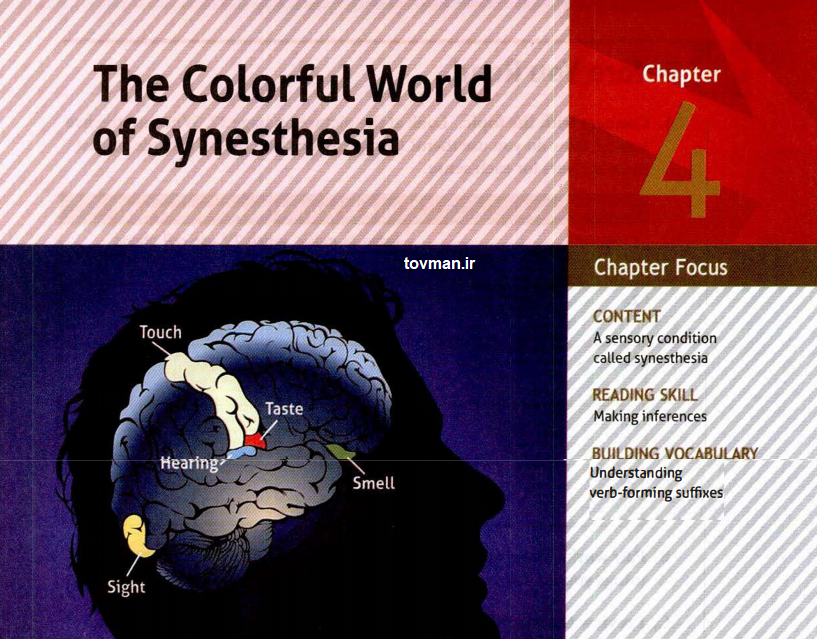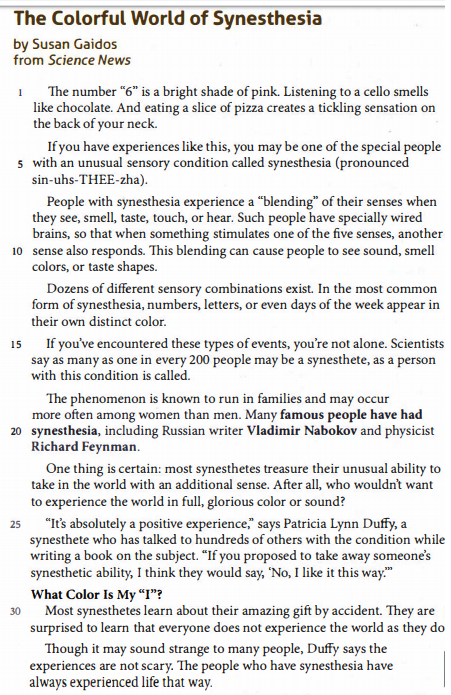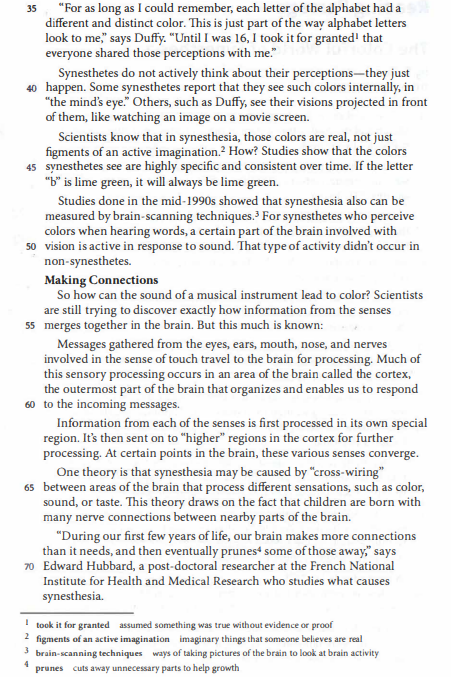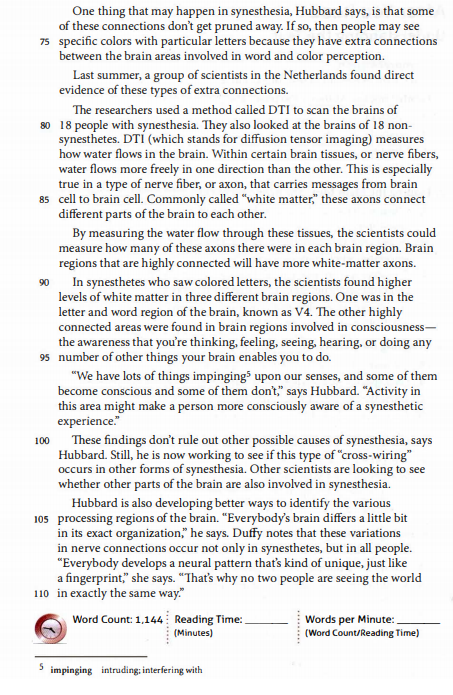
The Colorful World of Synesthesia
by Susan Gaidos
from Science News
دنیای رنگارنگ سیناستزی توسط سوزان گیدوس از اخبار علمي



The number "۶" is a bright shade of pink. Listening to a cello smells like chocolate. And eating a slice of pizza creates a tickling sensation on the back of your neck.
عدد "۶" سایه روشن رنگ صورتي است. گوش دادن به یک ویلون سل، بوی شکلات می دهد. و خوردن یک برش پیتزا احساس غلغلکي را در پشت گردن شما ایجاد می کند.
If you have experiences like this, you may be one of the special people with an unusual sensory condition called synesthesia (pronounced sin-uhs-THEE-zha).
اگر تجربیاتی مانند این را دارید ، ممکن است شما یکی از افراد خاص با وضعیت حسی غیرمعمول به نام سینستزی (تلفظ سين-اوس- ته- زا) باشید.
People with synesthesia experience a "blending" of their senses when they see, smell, taste, touch, or hear. Such people have specially wired brains, so that when something stimulates one of the five senses, another sense also responds. This blending can cause people to see sound, smell colors, or taste shapes.
افراد مبتلا به سینستزی "ترکیبی" از حواس خود، هنگام دیدن ، بوئیدن ، چشیدن، لمس کردن یا شنیدن را تجربه می کنند. چنین افرادی مغزهای عجيب خاصی دارند، به طوری که وقتی چیزی یکی از حواس پنجگانه را تحریک کند، حس دیگری نیز پاسخ می دهد. این ترکیب می تواند باعث شود افراد صدا را ببينند، رنگ ها را بو کنند یا اشکال را مزه کنند.
Dozens of different sensory combinations exist. In the most common form of synesthesia, numbers, letters, or even days of the week appear in their own distinct color.
دهها ترکیب مختلف حسی وجود دارد. در رایج ترین شکل سینستزی، اعداد، حروف و یا حتی روزهای هفته به رنگ متمایز خود ظاهر می شوند.
If you've encountered these types of events, you're not alone. Scientists say as many as one in every ۲۰۰ people may be a synesthete, as a person with this condition is called.
اگر با این نوع رویدادها روبرو شده اید، شما تنها نیستید. دانشمندان می گویند از هر ۲۰۰ نفر یک نفر ممکن است سينستازي باشد ، که به افرادي که اين اختلال را دارند گفته می شود.
The phenomenon is known to run in families and may occur more often among women than men. Many famous people have had synesthesia, including Russian writer Vladimir Nabokov and physicist Richard Feynman
معروف است که اين پديده در ميان خانواده ها ادامه پيدا کرده و ممکن است در زنان بيشتر از مردان رخ دهد. بسياري از افراد مشهور سینستزی را تجربه کرده اند، از جمله آنها ولاديمير نابوکوف نويسنده روسي و ريچارد فاينمن، فيزيکدان را مي توان نام برد.
One thing is certain: most synesthetes treasure their unusual ability to take in the world with an additional sense. After all, who wouldn't want to experience the world in full, glorious color or sound?
يک چيز مسلم است: بيشتر سينستازي ها توانايي غير معمول خود را براي درک جهان با يک حس اضافي، گرامي مي دارند. با اين وجود، چه کسي نمي خواهد جهان را بطور کامل با صدا و رنگي باشکوه تجربه کند؟
"It's absolutely a positive experience;' says Patricia Lynn Duffy, a synesthete who has talked to hundreds of others with the condition while writing a book on the subject. If you proposed to take away someone's synesthetic ability, I think they would say, 'No, I like it this way
"این کاملا یک تجربه مثبت است." پاتریشیا لین دافی که سينستازيي است و كسی است كه در هنگام نوشتن كتابي در این زمینه با صدها نفر دیگر که داراي اين شرايطند، صحبت كرده است؛ مي گويد: اگر شما پیشنهاد کنيد كه توانایی سینستزی كسی را از بین ببرد، فکر می كنم آنها می گویند ، نه، من این را همين طوري که هست، دوست دارم.
What Color Is My "I'?
Most synesthetes learn about their amazing gift by accident. They are surprised to learn that everyone does not experience the world as they do.Though it may sound strange to many people, Duffy says the experiences are not scary. The people who have synesthesia have always experienced life that way
رنگ من چيست؟
بيشتر سينستازي ها، استعداد خود را بصورت تصادفي در مي يابند. آنها متعجب مي شوند وقتي مي فهمند، آنطوري که آنها دنيا را تجربه مي کنند، ديگران تجربه نمي کنند. اگرچه ممکن است براي بسياري از افراد عجيب به نظر برسد؛ دافي مي گويد که اين تجربيات ترسناک نيست. افرادي که سینستزی دارند هميشه زندگي را از اين طريق تجربه کرده اند.
For as long as I could remember, each letter of the alphabet had a different and distinct color. This is just part of the way alphabet letters look to me;' says Duffy. "Until I was ۱۶, I took it for granted that everyone shared those perceptions with me
دافي مي گويد: تا آنجا که من به خاطر مي آورم، هر حرف از الفبا داراي يک رنگ متفاوت و متمايز بود و اين تنها بخشي از طريقي بود که حروف الفبا به نظر من مي آمد. تا ۱۶ سالگي قبول داشتم که هر کسي اين برداشت ها را با من در ميان بگذارد.
Synesthetes do not actively think about their perceptions-they just happen. Some synesthetes report that they see such colors internally, in "the mind's eye:' Others, such as Duffy, see their visions projected in front of them, like watching an image on a movie screen.
سينستازي ها در مورد برداشت هاي خود فکر مي کنند ، آنها فقط رخ مي دهند. بعضي سينستازي ها مي گويند چنين رنگ هايي را با چشم دل، بصورت دروني مي بينند. برخي ديگر همانند دافي اين تصورات را بصورت طرح ريزي شده در مقابل خود مي بينند؛ همانند ديدن تصويري بر روي یک صفحه نمايش.
Scientists know that in synesthesia, those colors are real, not just figments of an active imagination.How? Studies show that the colors synesthetes see are highly specific and consistent over time. If the letter "b" is lime green, it will always be lime green
.دانشمندان می دانند که در سینتزی، این رنگها واقعی هستند، نه فقط تخیل فعال. چگونه؟ مطالعات نشان می دهد که رنگ هایي که سیناتزی ها مي بينند بطور خاص مشخص و با گذشت زمان ثابت هستند. اگر حرف "ب" سبز ليموئي است، همیشه سبز ليموئي خواهد بود.
Studies done in the mid-۱۹۹۰s showed that synesthesia also can be measured by brain-scanning techniques.For synesthetes who perceive colors when hearing words, a certain part of the brain involved with vision is active in response to sound. That type of activity didn't occur in non-synesthetes.
مطالعات انجام شده در اواسط دهه ۱۹۹۰ نشان داد كه سینستزی نیز با روشهای اسكن مغز قابل اندازه گیری است. برای سیناتسزی هایی كه هنگام شنیدن كلمات، رنگ را درک می كنند، بخش خاصی از مغز درگیر با بینایی در پاسخ به صدا فعال است. این نوع فعالیت در غیر سیناتسزی ها رخ نمی دهد.
Making Connections
So how can the sound of a musical instrument lead to color? Scientists are still trying to discover exactly how information from the senses merges together in the brain. But this much is known:
ایجاد ارتباطات
بنابراین چگونه صدای یک ساز موسیقی می تواند منجر به رنگ شود؟ دانشمندان هنوز تلاش می کنند تا دقیقاً چگونگی ادغام اطلاعات حواس در مغز را کشف کنند. اما این بسیار شناخته شده است:
Messages gathered from the eyes, ears, mouth, nose, and nerves involved in the sense of touch travel to the brain for processing. Much of this sensory processing occurs in an area of the brain called the cortex, the outermost part of the brain that organizes and enables us to respond to the incoming messages
پیام های جمع آوری شده از چشم ، گوش ، دهان ، بینی و اعصاب درگیر در حس لامسه، برای پردازش به مغز مي روند. بخش اعظم این پردازش حسی در ناحیه ای از مغز به نام کورتکس اتفاق مي افتد، بیرونی ترین قسمت از مغز که سازماندهي را انجام مي دهد و ما را قادر می سازد تا به پیام های دریافتی پاسخ دهیم.
Information from each of the senses is first processed in its own special region. It's then sent on to "higher" regions in the cortex for further processing. At certain points in the brain, these various senses converge
اطلاعات مربوط به هر یک از حواس ابتدا در منطقه ویژه خود پردازش می شود. سپس برای پردازش بیشتر به مناطق "بالاتر" در کورتکس فرستاده می شود. در نقاط معینی از مغز، این حواس مختلف همگرا می شوند.
One theory is that synesthesia may be caused by "cross-wiring" between areas of the brain that process different sensations, such as color, sound, or taste. This theory draws on the fact that children are born with many nerve connections between nearby parts of the brain.
یک تئوری این است که سینستزی ممکن است در اثر "سیم کشی متقابل" بین مناطقی از مغز ایجاد شود که احساسات مختلفی مانند رنگ، صدا یا چشایی را پردازش می کنند. این نظریه این واقعیت را تکمیل می کند که کودکان با بسیاری از اتصالات عصبی بین قسمت های مجاور مغز، متولد می شوند.
During our first few years of life, our brain makes more connections than it needs, and then eventually prunes۴ some of those away;' say Edward Hubbard, a post-doctoral researcher at the French National Institute for Health and Medical Research who studies what causes synesthesia
مادوارد هوبارد، محقق فوق دکترا در انستیتوی تحقیقات بهداشتی و پزشکی ملی فرانسه که بر روی عواملی که باعث ایجاد سینستزی می شود مطالعه می کند، می گوید: طی چند سال اول زندگی، مغز ما بیشتر از آنچه لازم است، اتصالات برقرار می کند، و سپس سرانجام برخی از آنها را از بین می برد.
One thing that may happen in synesthesia, Hubbard says, is that some of these connections don't get pruned away. If so, then people may see specific colors with particular letters because they have extra connections between the brain areas involved in word and color perception
هوبارد می گوید، یک مورد که در سینتزی رخ می دهد این است که برخی از این اتصالات از بین نمی روند. در این صورت، ممکن است مردم رنگهای خاصی را با حروف خاص ببینند، زیرا بین مناطق مغز درگیر در درک کلمه و رنگ، اتصالات اضافی وجود دارد.
Last summer, a group of scientists in the Netherlands found direct evidence of these types of extra connections.
تابستان گذشته، گروهی از دانشمندان در هلند شواهد مستقیمی از این نوع اتصالات اضافی پیدا کردند.
The researchers used a method called DTI to scan the brains of so ۱۸ people with synesthesia. They also looked at the brains of ۱۸ nonsynesthetes. DTI ( which stands for diffusion tensor imaging) measures how water flows in the brain. Within certain brain tissues, or nerve fibers, water flows more freely in one direction than the other. This is especially true in a type of nerve fiber, or axon, that carries messages from brain cell to brain cell. Commonly called "white matter;' these axons connect different parts of the brain to each other.
محققان از روشی به نام DTI برای اسکن مغز ۱۸ فرد مبتلا به سینستزی استفاده کردند. آنها همچنین به مغزهای ۱۸ فرد سالم نگاه کردند. DTI (که مخفف تصویربرداری از تانسور انتشار نوعی روش تصویربرداری در ام آر آی است) چگونگی جریان آب در مغز را اندازه گیری می کند. در بافتهای خاصی از مغز یا الیاف عصبی، آب آزادتر در یک جهت از جهت دیگر جریان می یابد. این امر به ویژه در نوعی فیبر عصبی یا آکسون صادق است که پیامهایی از سلول مغزی به سلولهای مغزی منتقل می کند. معمولاً "ماده سفید" نامیده می شود. این آکسونها قسمتهای مختلف مغز را به یکدیگر متصل می کنند.
By measuring the water flow through these tissues, the scientists could measure how many of these axons there were in each brain region. Brain regions that are highly connected will have more white-matter axons.
دانشمندان می توانند با اندازه گیری جریان آب در بین این بافت ها، تعداد این آکسون ها را در هر منطقه از مغز اندازه گیری کنند. نواحی مغزی که به هم بسیار متصل هستند دارای آکسون هایی با ماده سفید هستند.
In synesthetes who saw colored letters, the scientists found higher levels of white matter in three different brain regions. One was in the letter and word region of the brain, known as V ۴. The other highly connected areas were found in brain regions involved in consciousness the awareness that you're thinking, feeling, seeing, hearing, or doing any number of other things your brain enables you to do
دانشمندان در افراد سینتسیزی که حروف رنگی را می دیدند؛ در سه ناحیه مختلف مغز سطح بالایی از ماده سفید را یافتند. یکی در ناحیه حروف و کلمات مغز، که به V۴ معروف است، قرار داشت. سایر نواحی بسیار متصل، در نواحی از مغز یافت شدند که درگیر فهمیدن اطلاع یافتن از فکرکردن؛ احساس کردن، دیدن، شنیدن و یا کارهایی که مغز شما قادر است برای شما انجام دهد، هستند.
"We have lots of things impingings upon our senses, and some of them become conscious and some of them don't;' says Hubbard. ''Activity in this area might make a person more consciously aware of a synesthetic expenence.
هوبارد می گوید ما چیزهای زیادی داریم که بر حواس ما تاثیر می گذارند و بعضی از آنها آگاهانه اند و برخی آگاهانه نیستند. فعالیت در این ناحیه ممکن است است، عمداً فرد را نسبت به تجربیات سینتستیک، آگاهتر کند.
These findings don't rule out other possible causes of synesthesia, says Hubbard. Still, he is now working to see if this type of "cross-wiring" occurs in other forms of synesthesia. Other scientists are looking to see whether other parts of the brain are also involved in synesthesia.
هوبارد می گوید، این یافته هاعلل احتمالی دیگر، که موجب سیناستزی می شود را رد نمی کند. او هنوز در تلاش است تا ببیند که آیا این نوع سیم کشی متقابل در دیگر شکل های سینستزیا رخ می دهد یا خیر. دانشمندان دیگر در جستجوی این هستند که ببینند آیا دیگر قسمت های مغز هم با سیناستزی درگیر هستند.
Hubbard is also developing better ways to identify the various processing regions of the brain. "Everybody's brain differs a little bit in its exact organization;' he says. Duffy notes that these variations in nerve connections occur not only in synesthetes, but in all people. "Everybody develops a neural pattern that's kind of unique, just like a fingerprint;' she says. "That's why no two people are seeing the world in exactly the same way.
هوبارد همچنین در حال توسعه روشهای بهتری برای شناسایی نواحی مختلف پردازش مغز است. او می گوید مغز هر کس در سازماندهی دقیق خود، کمی متفاوت است. دافی خاطرنشان می کند که این تغییرات در اتصالات عصبی نه تنها در سینستازی ها بلکه در همه افراد رخ می دهد. او می گوید:هر کسی یک الگوی عصبی منحصر بفرد درست همانند اثر انگشت دارند. به همین دلیل است که هیچ دو نفری؛ دقیقاً دنیا را یک طور نمی بینند.

